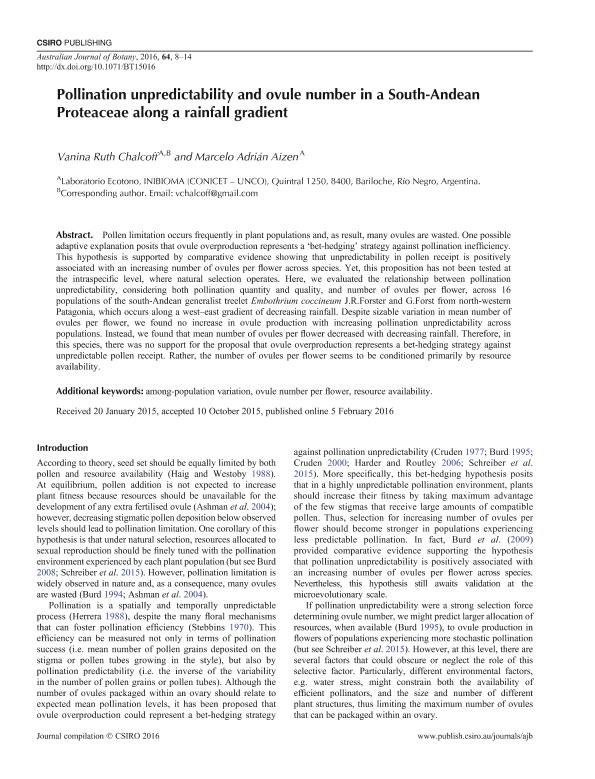Mostrar el registro sencillo del ítem
dc.contributor.author
Chalcoff, Vanina Ruth

dc.contributor.author
Aizen, Marcelo Adrian

dc.date.available
2018-12-20T17:01:47Z
dc.date.issued
2016-02
dc.identifier.citation
Chalcoff, Vanina Ruth; Aizen, Marcelo Adrian; Pollination unpredictability and ovule number in a South-Andean Proteaceae along a rainfall gradient; Csiro Publishing; Australian Journal of Botany; 64; 1; 2-2016; 8-14
dc.identifier.issn
0067-1924
dc.identifier.uri
http://hdl.handle.net/11336/66836
dc.description.abstract
Pollen limitation occurs frequently in plant populations and, as result, many ovules are wasted. One possible adaptive explanation posits that ovule overproduction represents a 'bet-hedging' strategy against pollination inefficiency. This hypothesis is supported by comparative evidence showing that unpredictability in pollen receipt is positively associated with an increasing number of ovules per flower across species. Yet, this proposition has not been tested at the intraspecific level, where natural selection operates. Here, we evaluated the relationship between pollination unpredictability, considering both pollination quantity and quality, and number of ovules per flower, across 16 populations of the south-Andean generalist treelet Embothrium coccineum J.R.Forster and G.Forst from north-western Patagonia, which occurs along a west-east gradient of decreasing rainfall. Despite sizable variation in mean number of ovules per flower, we found no increase in ovule production with increasing pollination unpredictability across populations. Instead, we found that mean number of ovules per flower decreased with decreasing rainfall. Therefore, in this species, there was no support for the proposal that ovule overproduction represents a bet-hedging strategy against unpredictable pollen receipt. Rather, the number of ovules per flower seems to be conditioned primarily by resource availability.
dc.format
application/pdf
dc.language.iso
eng
dc.publisher
Csiro Publishing

dc.rights
info:eu-repo/semantics/openAccess
dc.rights.uri
https://creativecommons.org/licenses/by-nc-sa/2.5/ar/
dc.subject
Among-Population Variation
dc.subject
Ovule Number Per Flower
dc.subject
Resource Availability
dc.subject.classification
Otras Ciencias Biológicas

dc.subject.classification
Ciencias Biológicas

dc.subject.classification
CIENCIAS NATURALES Y EXACTAS

dc.title
Pollination unpredictability and ovule number in a South-Andean Proteaceae along a rainfall gradient
dc.type
info:eu-repo/semantics/article
dc.type
info:ar-repo/semantics/artículo
dc.type
info:eu-repo/semantics/publishedVersion
dc.date.updated
2018-11-13T20:35:19Z
dc.journal.volume
64
dc.journal.number
1
dc.journal.pagination
8-14
dc.journal.pais
Australia

dc.journal.ciudad
Collingwood
dc.description.fil
Fil: Chalcoff, Vanina Ruth. Consejo Nacional de Investigaciones Científicas y Técnicas. Centro Científico Tecnológico Conicet - Patagonia Norte. Instituto de Investigaciones en Biodiversidad y Medioambiente. Universidad Nacional del Comahue. Centro Regional Universidad Bariloche. Instituto de Investigaciones en Biodiversidad y Medioambiente; Argentina
dc.description.fil
Fil: Aizen, Marcelo Adrian. Consejo Nacional de Investigaciones Científicas y Técnicas. Centro Científico Tecnológico Conicet - Patagonia Norte. Instituto de Investigaciones en Biodiversidad y Medioambiente. Universidad Nacional del Comahue. Centro Regional Universidad Bariloche. Instituto de Investigaciones en Biodiversidad y Medioambiente; Argentina
dc.journal.title
Australian Journal of Botany

dc.relation.alternativeid
info:eu-repo/semantics/altIdentifier/doi/https://dx.doi.org/10.1071/BT15016
dc.relation.alternativeid
info:eu-repo/semantics/altIdentifier/url/http://www.publish.csiro.au/BT/BT15016
Archivos asociados
